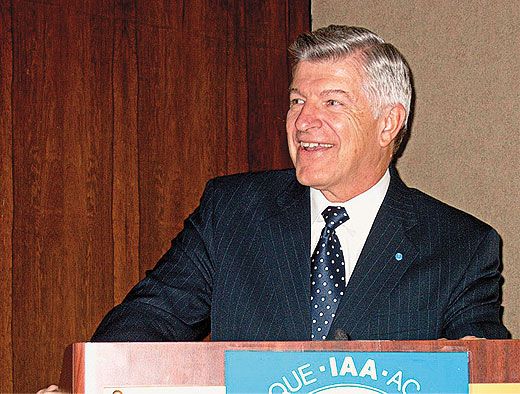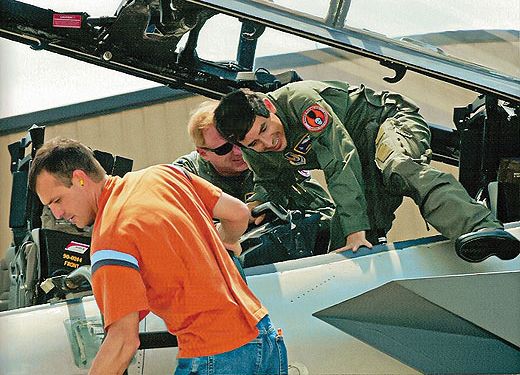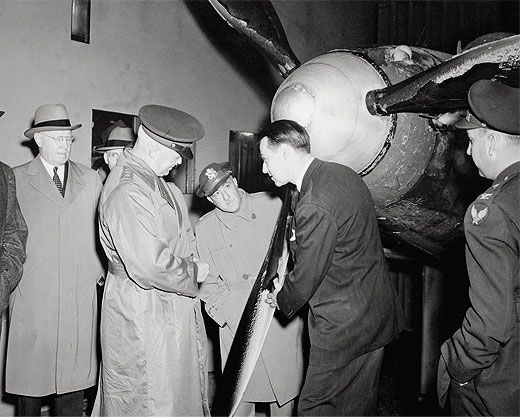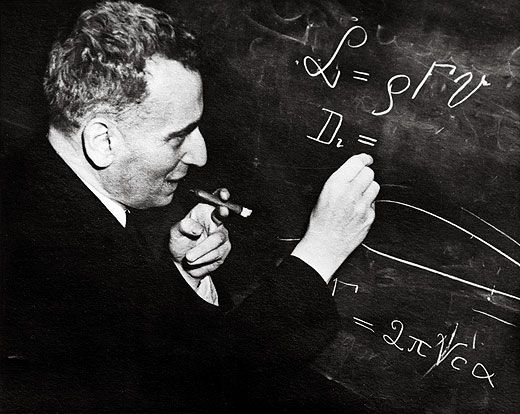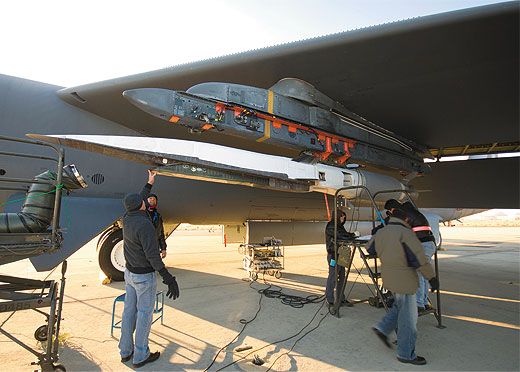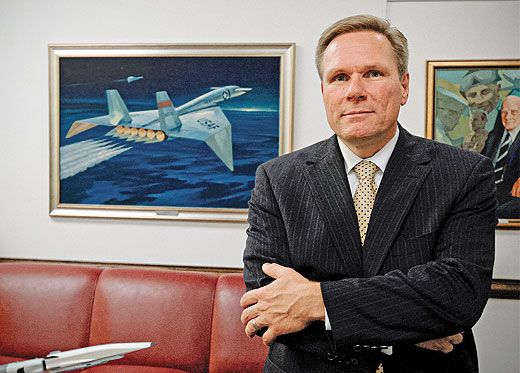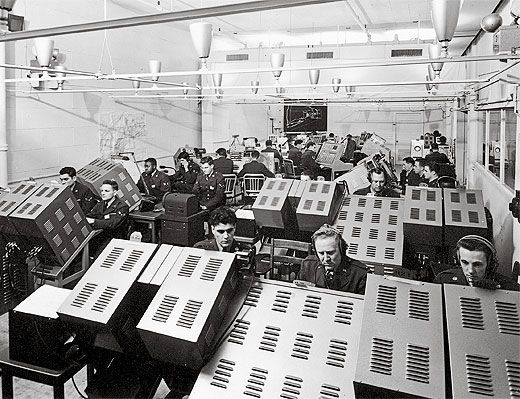How to Win Enemies and Influence Policy
From the halls of power to field laboratories, the Air Force Chief Scientist helps shape the future of U.S. flight.
/https://tf-cmsv2-smithsonianmag-media.s3.amazonaws.com/filer/Enemies_and_Influence_FLASH_AUG20101.jpg)
Shortly after starting his new job as Chief Scientist of the Air Force in the summer of 1973, Michael Yarymovych was at the Pentagon, attending a Department of Defense acquisitions meeting for satellite-based navigation—what is now known as the Global Positioning System. The meeting wasn’t going very well.
Ideas for satellite-based navigation had been in development since the 1960s, but the Navy and the Air Force fought over technical details and which service should control it. When the Air Force was named the lead for the Defense Navigation Satellite System, the Navy began dragging its feet, insisting that its own version, Timation, was better.
As the Air Force colonel in charge of the DNSS program was making his presentation, Yarymovych says, “a Navy admiral stood up and said, ‘Listen sonny, we’ve been navigating the seas for the last 3,000 years, and I really don’t care to know the difference between the bow and stern of my ship. Just place me on the surface of the ocean.’ ” The meeting fell apart and the program appeared dead.
But Yarymovych knew the idea of space-based navigation was beautiful; it just wasn’t being sold right. He went to his boss, Air Force Chief of Staff General John D. Ryan, and got another chance to get things going. Yarymovych began forging compromises among the Air Force, Army, and Navy, putting together the best pieces from all quarters. One of his tactics involved changing the name of the system, with help from Colonel Brad Parkinson, who headed up the Air Force’s DNSS proposal. “The Air Force was in the middle of Vietnam: they were in no mood to think of fancy new space programs,” says Yarymovych. In a fighter pilot culture focused on pointy jets and dogfights, “satellite was a bad word, so I said, ‘Why call it satellite? You have LORAN, you don’t call it an antenna. It gives your position any place on the globe, right? So it’s a global positioning system.’ And it stuck.”
The Chief Scientist of the Air Force is a uniquely influential position. It is a temporary appointment for an accomplished civilian scientist or engineer, from academia or industry, to advise the Air Force on science and technology programs, clearly including selling them. He (no woman has yet served) works directly under the Secretary of the Air Force and the Chief of Staff and carries the authority of a three-star general, but wields no actual power, makes no decisions, controls no budget, and commands a staff of only two: a military assistant and an executive secretary.
It took a couple of visionaries to realize that the Air Force needs scientific advice and to create a position that supplies it. Theodore von Kármán, a leading engineer and physicist of the 20th century, was a Hungarian émigré who in 1930 had become director of the Guggenheim Aeronautical Laboratory of the California Institute of Technology (GALCIT), where he did pioneering research in aeronautics and rocketry. In 1944, he founded the Jet Propulsion Laboratory in Pasadena. General H. “Hap” Arnold, who had learned to fly at the Wright brothers’ school and who became the commander of the Army Air Forces, saw building for the future as his life’s work. When America was swept into World War II, Arnold was dismayed to discover that in aeronautical technology, the United States was trailing not only its enemies but even its allies. When America’s test jet fighter, the Bell XP-59A, took off in 1942, it was powered by copies of a British-designed engine.
“That shocked Arnold,” says aviation historian Richard Hallion. “He never again wanted to see the Army Air Forces dependent for its scientific advice on an outside organization.”
In September 1944, Arnold summoned von Kármán to a meeting, where the general explained that although he was confident that the Allies had won the current war, he was worried about the next: With the advent of jet propulsion, radar, and missiles, what was air power’s future? He tasked von Kármán to gather a team of experts to chart a course. The report that resulted, Toward New Horizons, extrapolated scientific and technological progress decades ahead, with specific recommendations on how the Air Force could strengthen its research and development capabilities and on the use of technical advances.
But when Arnold retired in 1946, von Kármán lost his strongest advocate. The following year, the Air Force became an independent service under General Carl Spaatz, who didn’t share Arnold’s enthusiasm for science. Historian Dwayne Day notes in his book Lightning Rod: A History of the Air Force Chief Scientist’s Office: “Although the Air Force enthusiastically endorsed the idea of accepting scientific advice and guidance, top Air Force officers were often unwilling to accept much of the advice, particularly if it conflicted with the service’s current modes of operation and its cultural identity.” In particular, the Air Force was advised to look into ballistic missiles, but the old-school bomber pilots running the show considered missiles and rockets the stuff of Buck Rogers—and missiles and rockets didn’t need pilots.
Von Kármán approached General Hoyt Vandenberg, who in 1948 had succeeded Spaatz as Chief of Staff, and pointed out what World War II had amply demonstrated: Wars could be won with science. In Toward New Horizons, von Kármán had recommended a Scientific Advisory Board to advise the Air Force hierarchy, and the service had agreed. Vandenberg assigned the board to form a committee to evaluate how best to integrate scientific research and development into the Air Force. The committee, chaired by physicist Louis Ridenour of the Massachusetts Institute of Technology and the University of Illinois, produced a report that criticized the majority of the Air Force for a lack of interest in science and technology, among other things, and recommended the establishment of a Deputy Chief of Staff for Development and the Air Research and Development Command.
One suggestion of the Ridenour report was that the Air Force hire leading scientists to serve as advisors for one or two years. In May 1950, the new Deputy Chief of Staff for Development, Major General Gordon Saville, asked Ridenour himself if he would be interested in such a position. In September, Ridenour was appointed Chief Scientist.
The cold war had just warmed up in Korea, the Soviet Union had built an atomic bomb, and America was struggling with the question of building an H-bomb and intercontinental ballistic missiles. The defense of North America from air attack was one of Ridenour’s first concerns. Along with colleague Ivan Getting (who had earlier turned down Saville’s request to advise him on science issues), Ridenour pushed for establishing the Lincoln Laboratory, a research center for air defense, at MIT. He was also instrumental in instituting a series of seminars at MIT that brought together top scientists and strategists and in which projects such as the Distant Early Warning Line and the Semiautomatic Ground Environment (SAGE) air defense computing and relay system were conceived.
Dan Hastings, an MIT physicist, served as Chief Scientist in the late 1990s. One of his first big projects was “Doable Space,” which recommended a greater reliance on commercial launches. As Chief Scientist, “you have authority over nothing,” he says, “but you have a great deal of influence, which stems from the fact that it’s a direct reporting relationship to the Chief and the Secretary. In a hierarchical organization like the military, the fact that you talk directly to the Chief and the Secretary means a great deal. You realize the average colonel and even the average one-star or two-star [general], they never talk to the chief and the secretary. They only talk to the level above them.”
Chief Scientists have ranged from aerodynamicists and aeronautical engineers to physicists, computer scientists, mechanical engineers, and even a physiologist. “You have to find people who are polymaths, who have a tremendous sense of scientific and technical curiosity,” says Hallion.
An aeronautical engineer with an intense interest in spaceflight, Mike Yarymovych had worked for NASA on the Apollo program and had served as NASA’s representative to the Air Force’s Manned Orbiting Laboratory. He was asked to become Chief Scientist in 1973. “In the second year I ran a study using the old von Kármán name; I called it New Horizons II.” The study predicted that space would increase in importance as an arena for both civilian and military activities, and that computers would keep getting smaller and more ubiquitous. “At that time we were still dealing with IBM 650s—huge machines—and we’re saying, ‘We’re going to have several computers on each wing of an airplane,’ ” Yarymovych says. “The thought of miniaturizing processors and sticking them all over the place was kind of radical.”
Yarymovych’s prediction that the Air Force was entering “the age of computational plenty” wasn’t exactly welcomed. “At that time [it was] so revolutionary that it got [semi-] classified and put away because it was going to shake up a lot of things,” he says. “It finally got declassified 20 years later.” But there was still an indirect effect. A debate was flaring in the Pentagon over new fighter aircraft, specifically their designs and missions. “The discussion was the so-called high-low mix of fighters,” says Yarymovych. “The [air superiority] F-15 was already being built, so the thought was ‘How do you justify the [fighter-bomber] F-16?’ Going back to my New Horizons study—when I said computers everywhere and small is beautiful, never mind the big things—they used that as one of the reasons to justify a smaller airplane.”
The many issues on which the Chief Scientist has provided counsel reads like a history of Air Force technology. Examples and associated individuals include the development of supersonic aircraft (Horton Stever, Courtland D. Perkins), the integration of ballistic missiles into military strategy (George Valley), the rise and fall of the supersonic bomber (Joseph Charyk), increasing reliance on satellites and human spaceflight (Yarymovych and pretty much every Chief Scientist since Sputnik), remotely piloted vehicles (John Fisher, George Abrahamson), and directed-energy weapons (Dan Hastings). The Chief Scientist helped acquaint Air Force leadership with the potential of each new technology, easing its transition from the laboratory to the operational world.
Occasionally the Chief Scientist serves the opposite function: preventing the Air Force from squandering its budget on impractical ideas. “One of my biggest challenges was reeling them back sometimes,” says hypersonics expert Mark Lewis of the University of Maryland, who served as Chief Scientist from 2004 to 2008. “Someone would get a briefing on some latest or greatest technology and say, ‘Wow, we got to do this,’ and I’d have to say, ‘That briefing looked good, but let’s dig into this a little more.’ One of the first issues [during Lewis’ years] was a lot of interest in really high altitude. Some of the near-space solutions involved the use of airships. There are things that airships can do very well. There are things that airships can’t do very well, and one of those is flying at extraordinarily high altitudes and holding your position over a single spot on the Earth. And yet we had folks with viewgraphs where they’d imagine these magical airships that were hovering at some incredible altitude over some fixed point on the Earth for long duration.”
Actually, says Lewis, being the naysayer is a big part of being Chief Scientist: “You’re the guy telling people that their baby is ugly, that their concept doesn’t work, and sometimes you have to tell them why their concept violates the basic laws of physics. Not always a popular position to maintain.” In fact, the Chief of Staff once told Lewis that “if people aren’t calling and complaining about you, you’re not doing your job.”
He recalls the design of control stations for unmanned aerial vehicles. “Some of these weren’t very ergonomic. Instead of being designed to look like a cockpit, the control stations were menu-driven, the way a home computer operates. In most cases, this is a poor way to control an airplane. I brought this to the Chief and Secretary, along with the candid observation that the Air Force organization in charge of procuring our control stations was not doing enough to improve them.”
The Chief of Staff at the time, General Michael Moseley, was an ex-fighter pilot who immediately saw the advantages of Lewis’ suggestions and implemented the changes. Still, the Chief Scientist had stepped on a few toes, most notably those of the general who was in charge of the UAV control station project. “I learned a new four-letter word from that very upset general,” Lewis observes wryly. (The Chief of Staff later told Lewis, “Partner, it’s always good to expand your vocabulary.”)
The Chief Scientist also deals with fairly mundane but no less important issues. Lewis, for example, mentions “sustainment”: essentially, keeping the Air Force’s aircraft and other assets up and running. “The average age of an airplane in the Air Force is about 26 years,” he says. “Airplanes were literally falling apart in the sky.” (In 2007, a National Guard F-15 had come apart in flight, and when an investigation found that faulty longerons could cause fatigue cracks, the fleet was grounded.) “Keeping old airplanes flying, better diagnostic and repair techniques, ways of repairing old parts with newer parts, old materials with new materials, was an area that I focused on.”
Lewis and his military assistant, Colonel Rob Fredell, also an engineer, looked into the use of new hybrid composite materials in aircraft. “One of these materials is called GLARE and combines glass fibers with thin aluminum slices,” Lewis says. “The result is a material that is stronger and lighter than aluminum, but is very crack-resistant and has the repairability of aluminum. Repairing pure composites can be challenging.” Lewis instituted a research effort on GLARE materials at the Air Force Research Laboratory in partnership with contractors such as Lockheed Martin and Alcoa, proving the economic and engineering advantages of using such materials in transports and other aircraft.
The Chief Scientist is invariably on leave from a secure academic or industry position, is paid by the Pentagon at the same rate as that prior job, and serves knowing the old job will be there when his term is up. “It’s not a launching pad to some other job in the Department of Defense,” says Lewis, “which means that the Chief Scientist really isn’t worried about the political consequences of telling the truth.” Mike Yarymovych compares the job to that of a court jester: “You sit at the foot of the king’s throne, and while the courtiers are telling him what he wants to hear, the court jester tells him the truth and gets away with it without getting his head chopped off.”
The biggest project for current Chief Scientist Werner Dahm is heading up a comprehensive study to define a science and technology vision for the next 20 years, much as von Kármán did in the 1940s. It’s particularly critical now, says Dahm: “There are a lot of people who say, ‘Gee, what a terrible time to be Chief Scientist,’ because the budget looks miserable, and at some level that’s true. But that’s exactly when you have to make sure that you have clarity on where the highest-payoff science and technology investments are going to be. I’m having a great time.”
Mark Wolverton is the author of A Life in Twilight: The Final Years of J. Robert Oppenheimer (St. Martin’s Press, 2008).
